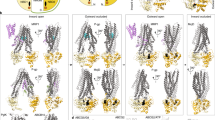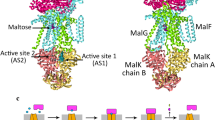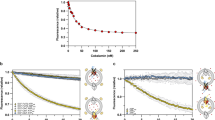Abstract
ATP-binding cassette (ABC) transporters are integral membrane proteins that translocate a diverse array of substrates across cell membranes. We present here the dynamics of complex formation of three structurally characterized ABC transporters—the BtuCD vitamin B12 importer and MetNI d/l-methionine importer from Escherichia coli and the Hi1470/1 metal-chelate importer from Haemophilus influenzae—in complex with their cognate binding proteins. Similarly to other ABC importers, MetNI interacts with its binding protein with low affinity (Kd ∼10−4 M). In contrast, BtuCD–BtuF and Hi1470/1–Hi1472 form stable, high-affinity complexes (Kd ∼10−13 and 10−9 M, respectively). In BtuCD–BtuF, vitamin B12 accelerates the complex dissociation rate ∼107-fold, with ATP having an additional destabilizing effect. The findings presented here highlight substantial mechanistic differences between BtuCD–BtuF, and likely Hi1470/1–Hi1472, and the better-characterized maltose and related ABC transport systems, indicating that there is considerable mechanistic diversity within this large protein super-family.
This is a preview of subscription content, access via your institution
Access options
Subscribe to this journal
Receive 12 print issues and online access
$189.00 per year
only $15.75 per issue
Buy this article
- Purchase on Springer Link
- Instant access to full article PDF
Prices may be subject to local taxes which are calculated during checkout







Similar content being viewed by others
References
Higgins, C.F. ABC transporters: from microorganisms to man. Annu. Rev. Cell Biol. 8, 67–113 (1992).
Higgins, C.F. ABC transporters: physiology, structure and mechanism–an overview. Res. Microbiol. 152, 205–210 (2001).
van der Does, C. & Tampe, R. How do ABC transporters drive transport? Biol. Chem. 385, 927–933 (2004).
Davidson, A.L., Dassa, E., Orelle, C. & Chen, J. Structure, function, and evolution of bacterial ATP-binding cassette systems. Microbiol. Mol. Biol. Rev. 72, 317–364 (2008).
Locher, K.P. Review. Structure and mechanism of ATP-binding cassette transporters. Phil. Trans. R. Soc. Lond. B 364, 239–245 (2009).
Jones, P.M., O'Mara, M.L. & George, A.M. ABC transporters: a riddle wrapped in a mystery inside an enigma. Trends Biochem. Sci. 34, 520–531 (2009).
Boos, W. & Lucht, J.M. Periplasmic binding protein-dependent ABC transporters. in Escherichia coli and Salmonella typhimurium: Cellular and Molecular Biology Vol. 1 (ed. Neidhardt, F.C.) 1175–1209 (American Society for Microbiology, Washington, DC, 1996).
Rohrbach, M.R., Braun, V. & Koster, W. Ferrichrome transport in Escherichia coli K-12: altered substrate specificity of mutated periplasmic FhuD and interaction of FhuD with the integral membrane protein FhuB. J. Bacteriol. 177, 7186–7193 (1995).
Doeven, M.K., Abele, R., Tampe, R. & Poolman, B. The binding specificity of OppA determines the selectivity of the oligopeptide ATP-binding cassette transporter. J. Biol. Chem. 279, 32301–32307 (2004).
Orelle, C., Ayvaz, T., Everly, R.M., Klug, C.S. & Davidson, A.L. Both maltose-binding protein and ATP are required for nucleotide-binding domain closure in the intact maltose ABC transporter. Proc. Natl. Acad. Sci. USA 105, 12837–12842 (2008).
Oldham, M.L., Khare, D., Quiocho, F.A., Davidson, A.L. & Chen, J. Crystal structure of a catalytic intermediate of the maltose transporter. Nature 450, 515–521 (2007).
Bassford, P.J. Jr., Bradbeer, C., Kadner, R.J. & Schnaitman, C.A. Transport of vitamin B12 in tonB mutants of Escherichia coli. J. Bacteriol. 128, 242–247 (1976).
Bassford, P.J. Jr. & Kadner, R.J. Genetic analysis of components involved in vitamin B12 uptake in Escherichia coli. J. Bacteriol. 132, 796–805 (1977).
Cadieux, N. et al. Identification of the periplasmic cobalamin-binding protein BtuF of Escherichia coli. J. Bacteriol. 184, 706–717 (2002).
Borths, E.L., Locher, K.P., Lee, A.T. & Rees, D.C. The structure of Escherichia coli BtuF and binding to its cognate ATP binding cassette transporter. Proc. Natl. Acad. Sci. USA 99, 16642–16647 (2002).
Hvorup, R.N. et al. Asymmetry in the structure of the ABC transporter binding protein complex BtuCD-BtuF. Science 317, 1387–1390 (2007).
Goetz, B.A., Perozo, E. & Locher, K.P. Distinct gate conformations of the ABC transporter BtuCD revealed by electron spin resonance spectroscopy and chemical cross-linking. FEBS Lett. 583, 266–270 (2009).
Dassa, E. & Bouige, E. The ABC of ABCs: a phylogenetic and functional classification of ABC systems in living organisms. Res. Microbiol. 152, 211–229 (2001).
Rees, D.C., Johnson, E. & Lewinson, O. ABC transporters: the power to change. Nat. Rev. Mol. Cell Biol. 10, 218–227 (2009).
Borths, E.L., Poolman, B., Hvorup, R.N., Locher, K.P. & Rees, D.C. In vitro functional characterization of BtuCD-F, the Escherichia coli ABC transporters for vitamin B12 uptake. Biochemistry 44, 16301–16309 (2005).
Chen, J., Sharma, S., Quiocho, F.A. & Davidson, A.L. Trapping the transition state of an ATP-binding cassette transporter: evidence for a concerted mechanism of maltose transport. Proc. Natl. Acad. Sci. USA 98, 1525–1530 (2001).
Liu, C.E. & Ames, G.F. Characterization of transport through the periplasmic histidine permease using proteoliposomes reconstituted by dialysis. J. Biol. Chem. 272, 859–866 (1997).
Merino, G., Boos, W., Shuman, H.A. & Bohl, E. The inhibition of maltose transport by the unliganded form of the maltose-binding protein of Escherichia coli: experimental findings and mathematical treatment. J. Theor. Biol. 177, 171–179 (1995).
Ames, G.F., Liu, C.E., Joshi, A.K. & Nikaido, K. Liganded and unliganded receptors interact with equal affinity with the membrane complex of periplasmic permeases, a subfamily of traffic ATPases. J. Biol. Chem. 271, 14264–14270 (1996).
van der Does, C., Presenti, C., Schulze, K., Dinkelaker, S. & Tampe, R. Kinetics of the ATP hydrolysis cycle of the nucleotide-binding domain of Mdl1 studied by a novel site-specific labeling technique. J. Biol. Chem. 281, 5694–5701 (2006).
Pick, U. The interaction of vanadate ions with the Ca-ATPase from sarcoplasmic reticulum. J. Biol. Chem. 257, 6111–6119 (1982).
Austermuhle, M.I., Hall, J.A., Klug, C.S. & Davidson, A.L. Maltose-binding protein is open in the catalytic transition state for ATP hydrolysis during maltose transport. J. Biol. Chem. 279, 28243–28250 (2004).
James, K.J., Hancock, M.A., Gagnon, J.N. & Coulton, J.W. TonB interacts with BtuF, the Escherichia coli periplasmic binding protein for cyanocobalamin. Biochemistry 48, 9212–9220 (2009).
Lundrigan, M.D., Koster, W. & Kadner, R.J. Transcribed sequences of the Escherichia coli btuB gene control its expression and regulation by vitamin B12 . Proc. Natl. Acad. Sci. USA 88, 1479–1483 (1991).
Richter-Dahlfors, A.A., Ravnum, S. & Andersson, D.I. Vitamin B12 repression of the cob operon in Salmonella typhimurium: translational control of the cbiA gene. Mol. Microbiol. 13, 541–553 (1994).
Van Hove, B., Staudenmaier, H. & Braun, V. Novel two-component transmembrane transcription control: regulation of iron dicitrate transport in Escherichia coli K-12. J. Bacteriol. 172, 6749–6758 (1990).
Khare, D., Oldham, M.L., Orelle, C., Davidson, A.L. & Chen, J. Alternating access in maltose transporter mediated by rigid-body rotations. Mol. Cell 33, 528–536 (2009).
Gorbulev, S., Abele, R. & Tampe, R. Allosteric crosstalk between peptide-binding, transport, and ATP hydrolysis of the ABC transporter TAP. Proc. Natl. Acad. Sci. USA 98, 3732–3737 (2001).
Herget, M. et al. Purification and reconstitution of the antigen transport complex TAP: A prerequisite for determination of peptide stoichiometry and ATP hydrolysis. J. Biol. Chem. 284, 33740–33749 (2009).
Chang, X.B., Hou, Y.X. & Riordan, J.R. ATPase activity of purified multidrug resistance-associated protein. J. Biol. Chem. 272, 30962–30968 (1997).
Ozvegy, C., Varadi, A. & Sarkadi, B. Characterization of drug transport, ATP hydrolysis, and nucleotide trapping by the human ABCG2 multidrug transporter. Modulation of substrate specificity by a point mutation. J. Biol. Chem. 277, 47980–47990 (2002).
Sauna, Z.E., Nandigama, K. & Ambudkar, S.V. Multidrug resistance protein 4 (ABCC4)-mediated ATP hydrolysis: effect of transport substrates and characterization of the post-hydrolysis transition state. J. Biol. Chem. 279, 48855–48864 (2004).
Quiocho, F.A. & Ledvina, P.S. Atomic structure and specificity of bacterial periplasmic receptors for active transport and chemotaxis: variation of common themes. Mol. Microbiol. 20, 17–25 (1996).
Eakanunkul, S. et al. Characterization of the periplasmic heme-binding protein shut from the heme uptake system of Shigella dysenteriae. Biochemistry 44, 13179–13191 (2005).
Ho, W.W. et al. Holo- and apo-bound structures of bacterial periplasmic heme-binding proteins. J. Biol. Chem. 282, 35796–35802 (2007).
Clarke, T.E., Braun, V., Winkelmann, G., Tari, L.W. & Vogel, H.J. X-ray crystallographic structures of the Escherichia coli periplasmic protein FhuD bound to hydroxamate-type siderophores and the antibiotic albomycin. J. Biol. Chem. 277, 13966–13972 (2002).
Karpowich, N.K., Huang, H.H., Smith, P.C. & Hunt, J.F. Crystal structures of the BtuF periplasmic-binding protein for vitamin B12 suggest a functionally important reduction in protein mobility upon ligand binding. J. Biol. Chem. 278, 8429–8434 (2003).
Locher, K.P., Lee, A.T. & Rees, D.C. The E. coli BtuCD structure: a framework for ABC transporter architecture and mechanism. Science 296, 1091–1098 (2002).
Pinkett, H.W., Lee, A.T., Lum, P., Locher, K.P. & Rees, D.C. An inward-facing conformation of a putative metal-chelate type ABC transporter. Science 315, 373–377 (2007).
Kadaba, N.S., Kaiser, J.T., Johnson, E., Lee, A. & Rees, D.C. The high-affinity E. coli methionine ABC transporter: structure and allosteric regulation. Science 321, 250–253 (2008).
Acknowledgements
We thank H. Pinkett for insightful discussions and critical reading of the manuscript and J. Klein and J. Vielmetter for their help in the initial BiaCore experiments. The work was supported in part by US National Institutes of Health grant GM045162, by the Howard Hughes Medical Institute and by fellowships to O.L. from the Fulbright Foundation and the Jane Coffin Childs Memorial Fund for Medical Research.
Author information
Authors and Affiliations
Contributions
A.T.L. and K.P.L. generated the original constructs used in this work; O.L. and D.C.R. designed the research; O.L. and A.T.L. performed the research; O.L., A.T.L., K.P.L. and D.C.R. analyzed the data; and O.L., K.P.L. and D.C.R. wrote the paper.
Corresponding author
Ethics declarations
Competing interests
The authors declare no competing financial interests.
Supplementary information
Supplementary Text and Figures
Supplementary Figures 1 and 2 and Supplementary Methods (PDF 232 kb)
Rights and permissions
About this article
Cite this article
Lewinson, O., Lee, A., Locher, K. et al. A distinct mechanism for the ABC transporter BtuCD–BtuF revealed by the dynamics of complex formation. Nat Struct Mol Biol 17, 332–338 (2010). https://doi.org/10.1038/nsmb.1770
Received:
Accepted:
Published:
Issue Date:
DOI: https://doi.org/10.1038/nsmb.1770
This article is cited by
-
Cryo-EM reveals unique structural features of the FhuCDB Escherichia coli ferrichrome importer
Communications Biology (2021)
-
Single-molecule probing of the conformational homogeneity of the ABC transporter BtuCD
Nature Chemical Biology (2018)
-
Single-molecule visualization of conformational changes and substrate transport in the vitamin B12 ABC importer BtuCD-F
Nature Communications (2017)
-
Structural basis of nanobody-mediated blocking of BtuF, the cognate substrate-binding protein of the Escherichia coli vitamin B12 transporter BtuCD
Scientific Reports (2017)
-
The uncoupled ATPase activity of the ABC transporter BtuC2D2 leads to a hysteretic conformational change, conformational memory and improved activity
Scientific Reports (2016)



